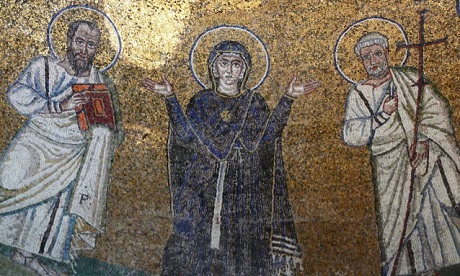There are plenty of artefacts showing women were present at the altars as priests and bishops in the early church, says researcher and historian Dr Ally Kateusz.
The trouble is, nobody’s noticed them or they’ve been hidden – some as recently as 1916.
The artefacts may help in the current debate over female ordination, which hinges on the role of women in early Christianity.
Kateusz, who is from the Wijngaards Institute for Catholic Research presented her research at Rome’s Pontifical Gregorian University last week.
She had examined fifth-century artefacts that show the early Christian liturgy “as it was performed at that time,” she says.
What she found was “A gender parallel liturgy – men and women at the altar.”
The three artefacts she focused on were:
- a fifth century ivory box that shows a woman standing next to an altar with a chalice on it (from Old St. Peter’s in Rome)
- a male and a female figure standing on either side of an altar while holding arms up in the orans pose – symbolically hinting at equality between both genders (from the Second Hagia Sophia, Constantinople)
- a mosaic depicting Mary the mother of Jesus, wearing a blue robe and bishop’s vestment, recognisable by the red cross and also holding the orans pose, next to two men in white (from theLateran Baptistery, Rome).
Kateusz thinks the first Christians were influenced by Jewish sects that gave men and women roles when they worshipped.
The theology for the liturgy would have been ‘there is neither Jew nor Greek, because both Jew and Greek were leaders in the ecclesia; there is neither free nor slave, because both were leaders in the ecclesia; and there is neither male nor female, and both were leaders in the ecclesia’,” she says.
Another example Kateusz mentions is at the San Venantius chapel in the Lateran Baptistery, Rome.
The seventh-century mosaic shows Mary wearing what appears to be a pallium, which is a symbol of episcopal authority given to new archbishops.
After the Vatican forbade images in 1916 of Mary dressed in vestments, the image was obscured.
Another researcher, Sister Christine Schenk, has published a book about the 3rd to 5th century sarcophagi at the Vatican’s Pio Cristiano museum of Christian antiquity showing women teaching and preaching surrounded by male disciple figures.
Source
- Daily Mail
- The Tablet
- Image: SlideShare
Additional reading
News category: World.




